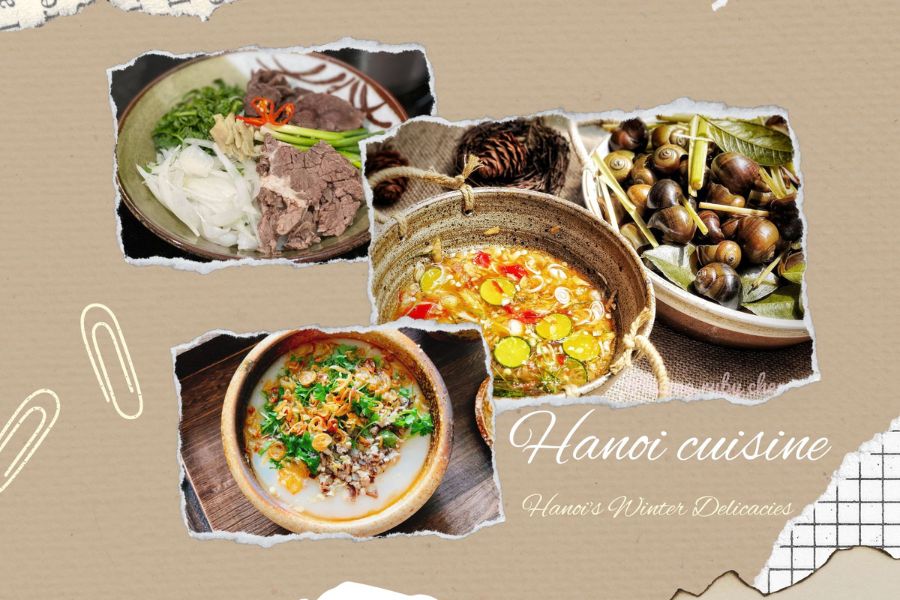The capital city of Hanoi always offers delicious treats throughout the seasons. Especially when the cold winds of Northeast Winter arrive, the chilly weather becomes interesting and warm when indulging in the winter delicacies of Hanoi at a sidewalk eatery.
Boiled Snails
In general, snail dishes and boiled snails, in particular, are popular and familiar to people not only in Hanoi but throughout the country. Wandering through small alleys, collective living areas in Hanoi, one can spot layers of people, young and old, passionately enjoying this simple yet sophisticated dish.
Unlike Saigon, Hanoi’s snails do not include stir-fried or tamarind-snail variations. The standard snail flavors in the capital include twisted snails, rock snails, or jackfruit snails, locally known as “big snails, small snails.” They are boiled with lemongrass and lime leaves, served with ginger and chili fish sauce, with snail extraction done with a grapefruit thorn or a sharp Western metal piece.

In winter, passing through any small alley or street, you can encounter excellent snail stalls. Some well-known addresses include Tong Duy Tan Snails, Cua Bac Snails, Luong Dinh Cua Snails, among others.
Boiled snails are delightful when enjoyed while still piping hot. Each snail is golden, plump, providing a perfect combination of crispiness and tenderness.
The unique point of Hanoi’s boiled snail stalls lies in their dipping sauce. Each stall, each chef has their unique sauce-making style, creating the reputation of these famous snail places.
However, the snail dipping sauce is almost made up of basic components: pure fish sauce mixed with a bit of lime and ginger, crushed lemongrass, finely sliced lime leaves, and fresh chili. Each ingredient contributes to the creation of a mildly spicy, sweet, and sour dipping sauce that anyone dipping into would praise for its deliciousness!
Hot Rice Cake (Banh Duc Nong)
In the cold season in Hanoi, one cannot miss the moments of savoring hot rice cakes from the land of the capital.
Hanoians make delicious hot rice cakes, and there are many famous places serving hot rice cakes in the capital that everyone knows, such as Banh Duc So 8 Le Ngoc Han, 296 Minh Khai, 106 Goc De, and Trung Tu Hot Rice Cake.
If traditional rice cakes in the Northern region are made to cool down and enjoy with braised fish, braised meat, shrimp paste, crab soup, etc., hot rice cakes are different. They are enjoyed while still hot, with clear water, and vegetables.
The process of making hot rice cakes starts with the basic steps of traditional rice cakes, from selecting rice to grinding the flour and molding the cakes. However, Hanoi’s hot rice cakes are softer and more flexible than traditional ones.
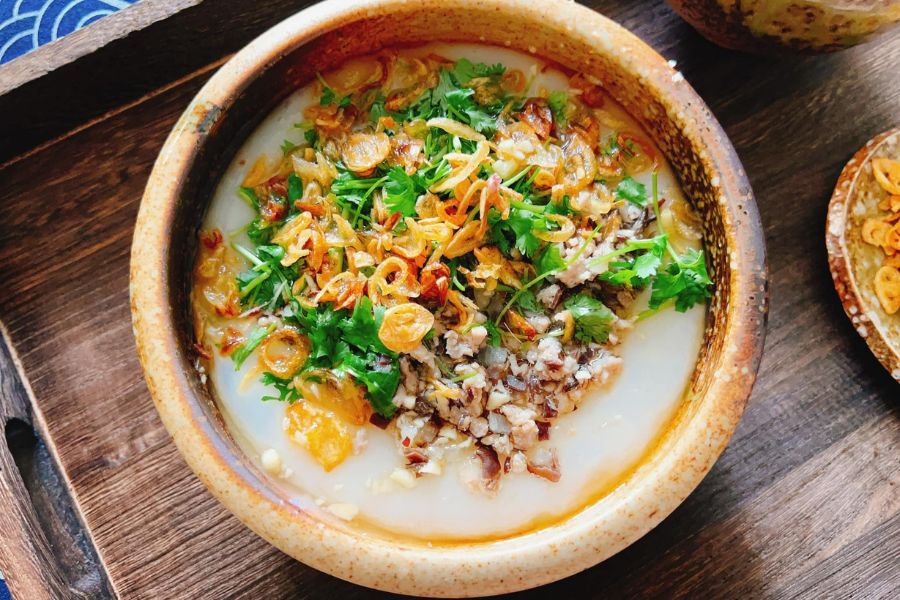
To have soft, flexible cakes that still smell of rice without the strong lime odor often found in traditional rice cakes, Hanoians carefully select rice, soak it just enough, grind the flour immediately, and use the cakes right away without letting them sit.
In addition to the quality of rice, the technique of grinding the flour, the deliciousness of Hanoi’s hot rice cakes also comes from the accompanying clear water.
The accompanying water has a sweet and refreshing taste, cleverly concocted with the secrets of the chef. Pouring the water onto the hot rice cakes adds a special flavor to the cakes, making them even more delicious, accompanied by a bit of fresh vegetables, fried onions, mung beans, and finely chopped lean meat sautéed just right.
Hanoi’s hot rice cakes are considered a simple yet suitable innovation to please customers in the cold weather of Northern winter. Hanoians have a habit; whenever winter comes, no matter the price, they must enjoy hot rice cakes, and this habit has become a hobby for tourists.
Banh Gio (Pyramid-Shaped Rice Cake)
Hanoi has many simple yet beloved dishes, and banh gio is one of them.
For breakfast, lunch, or dinner, Hanoians can enjoy banh gio at any time of the day without getting bored. An affordable dish that can be easily found on every street corner, sidewalk vendor, it still makes those living far away feel nostalgic.
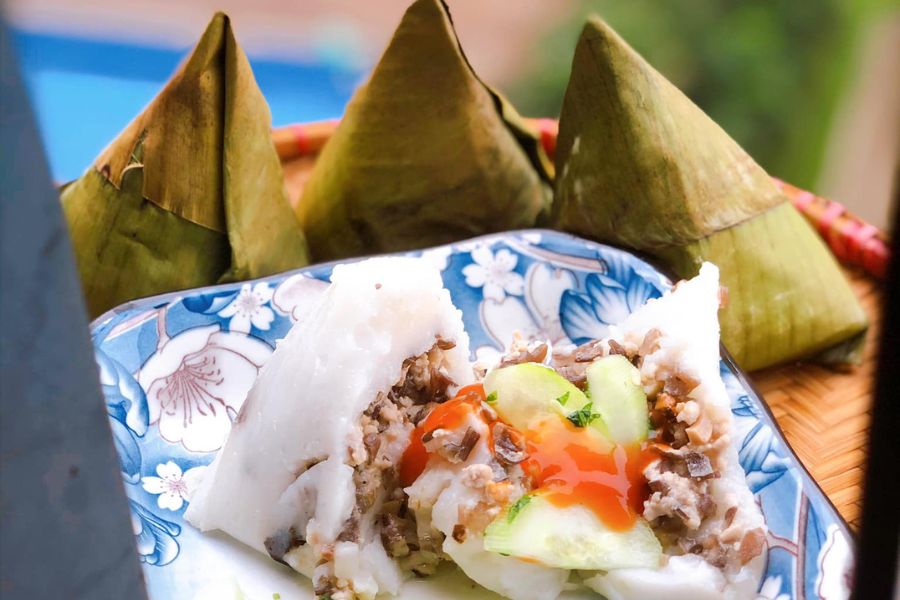
At first glance, the outer leafy layer makes diners hesitant as it doesn’t look appealing at all. However, when you open the hot cake, the white color of the rice flour appears, mixed with the pork and wood ear mushroom filling, creating an enticing charm for banh gio.
A “standard” banh gio is made from rice flour with a bit of glutinous rice flour. The filling includes a mixture of pork, wood ear mushrooms, dried shallots, pepper, salt, etc. Taking a bite, the soft outer layer immediately melts on the tongue, and the pork and wood ear mushrooms blend with the fragrant ground pepper, awakening all the senses. Add a bit of pickled radish, chili sauce, and the dish becomes perfect with various flavors.
Rib Porridge (Chao Suon)
When talking about rib porridge, Hanoi residents immediately think of images of women selling porridge on mobile stalls every morning or during busy evenings amidst the crowded streets.
On one side of the stall is a pot of simmering rib porridge emitting fragrant smoke, and on the other side, there are various utensils such as small stools, bowls, chopsticks, boxes of dried onions, and crispy fried dough sticks. The bowl of porridge is smooth and glossy, smelling aromatic, with a few pieces of pink ribs peeking out. Just looking at it makes one’s mouth water, and the stomach rumbles.
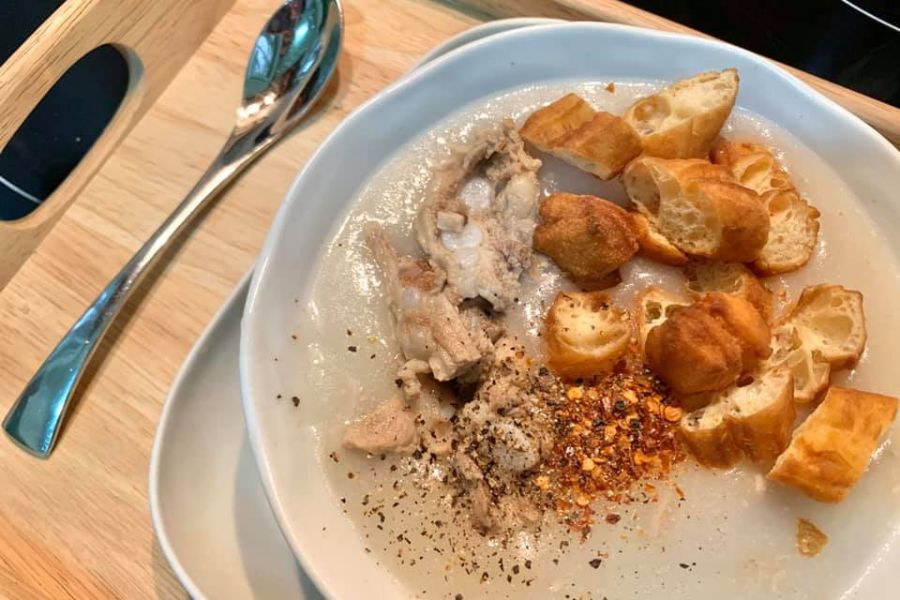
Hanoi-style rib porridge has the pure fragrance of freshly cooked rice mixed with the richness of young ribs. It’s enticing from the first whiff. Taking a spoonful, you immediately feel a sweet warmth in your throat. The sweetness from the bones, meat, and rice is unmatched by any artificial sweetness. Hanoians often eat rib porridge with fried dough sticks. A bit of fragrant pepper, a handful of fresh green onions, the porridge becomes perfect with a harmonious mix of flavors.
The ribs are not minced, but the cooks leave them in large, thick pieces. Still, just a gentle scoop with a spoon, and the meat separates from the bone, tender and sweet. It takes a lot of skill to make the ribs tender and delicious like this, and the taste of the porridge is gradually absorbed, creating an unforgettable experience.
Pho
Pho is a name closely associated with Hanoi, not only as a simple dish but also as the beauty and sophistication of culinary culture in the eyes of friends worldwide. In any season, not just winter, visiting Hanoi and savoring pho is an experience not to be missed. Perhaps nothing warms your heart faster in winter than… a bowl of pho.
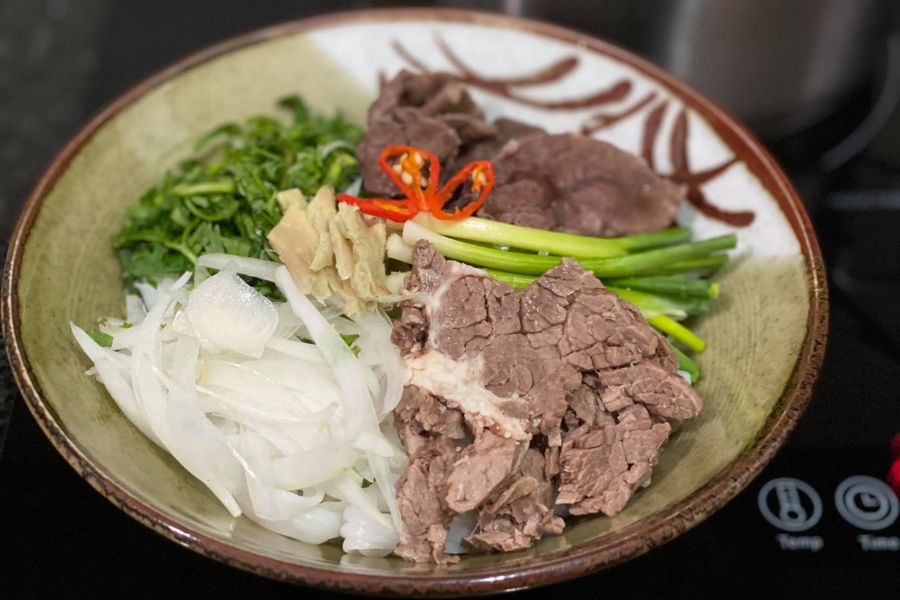
Rolling beef pho is a fascinating dish in Hanoi. Beef is quickly sautéed on a hot pan with green onions, fresh herbs, and spices before being added to the pho bowl. The owner just needs to add broth, which has been simmered with beef bones for hours, and a perfect bowl of pho is ready. The taste is discovered when the beef is just cooked, moist and flavorful. The onions are just right, without the pungent smell but still emit an attractive aroma.
The steaming, the rich taste, and the cloudy broth are the characteristics of rolling beef pho. If you want to taste this dish, you can visit traditional pho stalls on Lo Duc Street, Hai Ba Trung District.
As for those who want to enjoy traditional well-cooked beef pho in Hanoi, you can go to streets like Bat Dan, Hang Trong, Phung Hung, or Quang Trung to try the dish that has been associated with the capital for decades.
Well-cooked beef pho has beef that is cooked to perfection, still retaining its characteristic sweetness, without adding any spices. The onions are blanched until the white part is cooked just right, the crunchy sweetness without the pungent odor, and the green part is just cooked enough to eat. The broth is the signature of well-cooked beef pho, also the pride of the chefs. A lot of effort is put into simmering the bones day and night, combined with seasoning according to the traditional recipe, to achieve a broth that is clear, sweet, and captivating.
